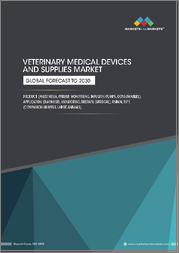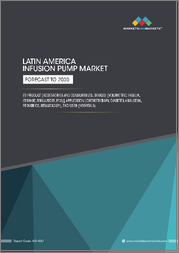
|
시장보고서
상품코드
1804707
휴대용 헤모글로빈 분석기 시장 : 제품 유형, 기술 유형, 용도, 최종사용자, 유통 채널별 - 세계 예측(2025-2030년)Portable Hemoglobin Analyzer Market by Product Type, Technology Type, Application, End User, Distribution Channel - Global Forecast 2025-2030 |
||||||
휴대용 헤모글로빈 분석기 시장은 2024년에는 4억 2,579만 달러로 평가되었으며, 2025년에는 4억 5,244만 달러, CAGR 6.45%로 성장하여 2030년에는 6억 1,959만 달러에 달할 것으로 예측됩니다.
| 주요 시장 통계 | |
|---|---|
| 기준 연도 2024년 | 4억 2,579만 달러 |
| 추정 연도 2025년 | 4억 5,244만 달러 |
| 예측 연도 2030년 | 6억 1,959만 달러 |
| CAGR(%) | 6.45% |
휴대용 헤모글로빈 분석기의 종합적인 도입으로 전 세계적으로 환자 결과를 개선하는 현장 진단에 혁명을 일으키고 있습니다.
휴대용 헤모글로빈 분석기는 임상의, 간병인, 환자가 임상 및 재택 환경에서 헤모글로빈 수치를 모니터링하는 방식을 변화시키며 현장진단(POC) 분야에서 매우 중요한 혁신으로 등장했습니다. 세계 인구의 고령화와 빈혈 및 만성질환의 유병률이 지속적으로 증가함에 따라 빠르고 신뢰할 수 있으며 사용하기 쉬운 검사 플랫폼에 대한 요구가 증가하고 있습니다. 이 기기는 헤모글로빈 농도를 거의 즉각적으로 평가할 수 있어 시간을 단축하고, 합병증을 예방하고 환자의 결과를 개선하는 적시 개입을 촉진합니다. 이러한 민첩성은 신속한 의사결정이 환자의 안전과 치료의 성공에 직접적인 영향을 미치는 헌혈 검사에서 종양 모니터링에 이르는 시나리오에서 매우 중요합니다.
현장 진료에서 휴대용 헤모글로빈 검사의 미래를 정의하는 주요 기술 혁신과 시장 역학에 대한 평가
휴대용 헤모글로빈 분석기를 둘러싼 환경은 기술적 혁신, 진화하는 지불자 모델, 변화하는 의료 제공 패러다임에 힘입어 변화의 시기를 맞이하고 있습니다. 센서의 기술 혁신은 현재 더 높은 감도와 특이도를 실현하여 실험실 수준의 성능과 핸드헬드 편의성 사이의 격차를 좁히고 있습니다. 이와 함께 인공지능을 활용한 알고리즘이 결과 해석을 정교화하여 사용자 오류를 최소화하고 임상의의 신뢰도를 높이고 있습니다. 이러한 추세의 수렴으로 장비의 정확성, 경제성, 사용 편의성에 대한 벤치마크가 재정의되고 있습니다.
미국 2025년 관세가 세계 휴대용 헤모글로빈 측정기 공급망, 비용, 혁신에 미치는 종합적 영향 분석
2025년 미국이 새로운 관세 정책을 시행하면 휴대용 헤모글로빈 분석기 산업, 특히 주요 제조 기지에서 수입되는 장비와 부품에 심각한 영향을 미칠 것입니다. 센서 모듈, 비색 시약, 분광광도계 어셈블리에 대한 관세는 세계 공급망에 의존하는 거래처 상표 제품 제조업체의 제조 비용을 상승시켰습니다. 이에 따라 일부 기업들은 북미 지역 공급업체 및 멕시코 근해 시설과 협력하여 관세의 영향을 줄이고 중요한 자재에 대한 지속적인 접근을 보장하면서 조달 전략을 재검토하고 있습니다.
헤모글로빈 검사 생태계를 형성하는 기술, 최종사용자, 용도, 제품 유형의 역학을 밝혀내는 시장 세분화에 대한 심층 분석
시장 세분화는 기술, 사용자, 용도, 제품 유형의 각 차원에 의해 정의되는 상황을 명확히 하고, 각 차원은 전략적 의사결정에 영향을 미칩니다. 기술적 측면에서 비색 시편은 단순한 디자인과 최소한의 시약 요구 사항으로 비용에 민감한 환경에 계속 호소력을 발휘하고 있으며, 전기화학 분석 플랫폼은 정확성과 빠른 응답 시간으로 인기를 끌고 있습니다. 분광광도계 장치는 높은 처리량 검사와 확립된 검증 프로토콜이 가장 중요한 임상 실험실에서 강력한 입지를 유지하고 있습니다.
휴대용 헤모글로빈 진단의 다양한 기회를 발견할 수 있는 아메리카, 유럽, 중동 및 아프리카, 아시아태평양의 전략적 지역 연구
지역 역학은 휴대용 헤모글로빈 분석기의 시장 성숙도, 보급률, 기술 혁신의 경로를 결정하는 데 있어 매우 중요한 역할을 합니다. 아메리카에서는 이미 확립된 상환 환경과 첨단 의료 인프라로 인해 급성기 의료와 재택의료 모두에서 도입이 가속화되고 있습니다. 디지털 헬스 솔루션이 광범위하게 통합되면서 원활한 데이터 공유와 원격 모니터링이 가능해졌고, 특히 북미에서는 원격의료에 대한 노력이 빠르게 확대되고 있습니다.
헤모글로빈 분석기 시장의 혁신, 제휴 및 전략적 움직임을 주도하는 저명한 업계 플레이어의 경쟁 정보를 공개합니다.
휴대용 헤모글로빈 분석기 시장의 경쟁 역학은 기존 의료기기 제조업체, 전문 진단업체, 신생 디지털 헬스 스타트업이 혼재되어 형성되고 있습니다. 레거시 제조업체들은 제약 규제에 대한 깊은 전문 지식과 세계 판매망을 지속적으로 활용하고 있으며, 센서의 정확성과 워크플로우 통합에 중점을 둔 제품 개선을 반복적으로 도입하고 있습니다. 동시에, 민첩한 신규 진입 기업들은 사용자 친화적인 인터페이스, 스마트폰과의 호환성, 장비와 시약 소모품을 번들로 제공하는 구독 기반 서비스 모델을 통해 차별화를 꾀하고 있습니다.
업계 리더가 휴대용 헤모글로빈 분석의 새로운 트렌드를 활용하고 시장 상황 분석을 강화하기 위한 전략적 로드맵
업계 리더들은 휴대용 분석 기기를 원격의료 플랫폼과 연계하여 종합적인 원격 환자 모니터링과 데이터 기반 의사결정 지원을 가능하게 하는 통합 디지털 생태계에 우선적으로 투자해야 합니다. 통일된 소프트웨어 인터페이스와 클라우드 기반 분석을 개발함으로써 기업은 하드웨어 판매에 그치지 않고, 구독 기반 진단 및 원격 자문 서비스를 포함한 차별화된 서비스 모델을 제공할 수 있습니다. 이러한 접근 방식은 지속적인 수익원을 창출할 뿐만 아니라 지속적인 참여를 통해 고객 충성도를 높일 수 있습니다.
휴대용 헤모글로빈 검사 솔루션의 미래를 이끌어갈 혁신적 트렌드와 전략적 중요사항에 대한 인사이트 요약
휴대용 헤모글로빈 분석기 시장은 기술 혁신, 규제 진화, 의료 제공 모델의 전환이 진단 패러다임의 재정의로 수렴되는 매우 중요한 교차로에 위치하고 있습니다. 원격의료의 보급, 검사의 분산화, 환자 중심 치료의 중요성과 같은 주요 추세는 다양한 임상 상황에서 신속하고 정확한 헤모글로빈 측정의 중요한 역할을 강조하고 있습니다. 또한, 관세 인상 압력과 공급망 문제에 대한 전략적 대응은 제조 현지화와 민첩한 조달을 촉진하고 업계의 회복력을 강화했습니다.
목차
제1장 서문
제2장 조사 방법
제3장 주요 요약
제4장 시장 개요
제5장 시장 역학
제6장 시장 인사이트
- Porter's Five Forces 분석
- PESTEL 분석
제7장 미국 관세의 누적 영향 2025
제8장 휴대용 헤모글로빈 분석기 시장 : 제품 유형별
- 벤치탑 디바이스
- AC구동
- 배터리식
- 핸드헬드 디바이스
제9장 휴대용 헤모글로빈 분석기 시장 : 기술 유형별
- 크로마토그래피 기반 분석기
- 전기화학
- POC(Point of Care) 검사(POCT)
- 분광광도계
제10장 휴대용 헤모글로빈 분석기 시장 : 용도별
- 빈혈 스크리닝
- 철결핍성 빈혈
- 거적아구성 빈혈
- 헌혈 스크리닝
- 만성질환 모니터링
- 종양학적 모니터링
- 신장질환 모니터링
- 조사 이용
- 학술 조사
- 임상시험
제11장 휴대용 헤모글로빈 분석기 시장 : 최종사용자별
- 혈액은행
- 진단 검사실
- 재택 케어 설정
- 병원
- 군사 및 긴급 서비스
제12장 휴대용 헤모글로빈 분석기 시장 : 유통 채널별
- 오프라인 판매
- 온라인 판매
제13장 아메리카의 휴대용 헤모글로빈 분석기 시장
- 미국
- 캐나다
- 멕시코
- 브라질
- 아르헨티나
제14장 유럽, 중동 및 아프리카의 휴대용 헤모글로빈 분석기 시장
- 영국
- 독일
- 프랑스
- 러시아
- 이탈리아
- 스페인
- 아랍에미리트
- 사우디아라비아
- 남아프리카공화국
- 덴마크
- 네덜란드
- 카타르
- 핀란드
- 스웨덴
- 나이지리아
- 이집트
- 튀르키예
- 이스라엘
- 노르웨이
- 폴란드
- 스위스
제15장 아시아태평양의 휴대용 헤모글로빈 분석기 시장
- 중국
- 인도
- 일본
- 호주
- 한국
- 인도네시아
- 태국
- 필리핀
- 말레이시아
- 싱가포르
- 베트남
- 대만
제16장 경쟁 구도
- 시장 점유율 분석, 2024
- FPNV 포지셔닝 매트릭스, 2024
- 경쟁 분석
- HemoCue by Danaher Corporation
- EKF Diagnostics Holdings plc.
- ACON Laboratories, Inc.
- Abbott Laboratories
- Cascade Health Care Inc.
- ARKRAY, Inc
- Clarity Diagnostics, LLC
- EzeRx Health Tech Private Limited
- Hoffmann-La Roche Ltd.
- HUMAN Diagnostics Worldwide
- Immunostics Inc.
- Labotronics Scientific Ltd.
- Masimo Corp.
- Nova Biomedical Corporation by Advanced Instruments, LLC.
- PixCell Medical Technologies Ltd.
- Siemens Healthineers AG
- True Diagnostics, Inc
- URIT Medical Electronic Co., Ltd.
제17장 리서치 AI
제18장 리서치 통계
제19장 리서치 컨택트
제20장 리서치 기사
제21장 부록
KSM 25.09.11The Portable Hemoglobin Analyzer Market was valued at USD 425.79 million in 2024 and is projected to grow to USD 452.44 million in 2025, with a CAGR of 6.45%, reaching USD 619.59 million by 2030.
| KEY MARKET STATISTICS | |
|---|---|
| Base Year [2024] | USD 425.79 million |
| Estimated Year [2025] | USD 452.44 million |
| Forecast Year [2030] | USD 619.59 million |
| CAGR (%) | 6.45% |
Comprehensive Introduction to Portable Hemoglobin Analyzers Revolutionizing Point of Care Diagnostics for Enhanced Patient Outcomes Globally
Portable hemoglobin analyzers have emerged as a pivotal innovation in point of care diagnostics, transforming how clinicians, caregivers, and patients monitor hemoglobin levels both in clinical environments and home settings. As the global population ages and the prevalence of anemia and chronic conditions continues to rise, the need for immediate, reliable, and user-friendly testing platforms has intensified. These devices enable near-instantaneous assessment of hemoglobin concentrations, reducing turnaround times and facilitating timely interventions that can prevent complications and improve patient outcomes. Such agility is crucial in scenarios ranging from blood donation screening to oncology monitoring, where rapid decision-making directly impacts patient safety and treatment success.
Recent advancements in sensor technology, miniaturization, and connectivity have further elevated the capabilities of these analyzers. Integration with digital health platforms allows real-time data transmission, remote monitoring, and seamless incorporation into electronic health records, thereby supporting telemedicine initiatives and enhancing continuity of care. Moreover, the push for decentralizing diagnostic services has empowered home care and self-testing environments, democratizing access to critical health information. Together, these developments underscore a shift toward more patient-centric, proactive healthcare models where portable hemoglobin analyzers serve as catalysts for improved clinical workflows and personalized disease management.
Assessing the Major Technological Breakthroughs and Market Dynamics Defining the Future of Portable Hemoglobin Testing at Point of Care
The portable hemoglobin analyzer landscape is undergoing transformative shifts driven by technological breakthroughs, evolving payer models, and changing care delivery paradigms. Sensor innovations now deliver higher sensitivity and specificity, narrowing the gap between laboratory-grade performance and handheld convenience. In parallel, artificial intelligence-enabled algorithms are refining result interpretation, minimizing user error and boosting clinician confidence. These converging trends are redefining the benchmarks for device accuracy, affordability, and ease of use.
Simultaneously, the rise of value-based care and remote patient monitoring has created fertile ground for point of care testing solutions that reduce hospitalizations and lower treatment costs. Healthcare systems are increasingly deploying portable analyzers in outpatient clinics, community health initiatives, and emergency response units, where rapid hemoglobin assessments inform triage decisions and resource allocation. As digital health ecosystems expand, seamless integration of device data into telehealth platforms enhances remote diagnostics and follow-up care. Consequently, traditional centralized laboratory models are yielding to hybrid frameworks that emphasize agility and patient engagement.
Moreover, regulatory agencies are streamlining approval pathways for point of care diagnostics that demonstrate robust clinical validation. This regulatory momentum is complemented by collaborative partnerships between medical device manufacturers, software providers, and academic institutions, fostering an environment of continuous innovation. In summary, these transformative shifts are coalescing to make portable hemoglobin analyzers indispensable tools in modern healthcare delivery.
Analyzing the Comprehensive Effects of United States 2025 Tariffs on Global Portable Hemoglobin Analyzer Supply Chains, Costs, and Innovation
The implementation of new United States tariff policies in 2025 has introduced significant implications for the portable hemoglobin analyzer industry, particularly for devices and components imported from key manufacturing hubs. Tariffs on sensor modules, colorimetric reagents, and spectrophotometric assemblies have elevated production costs for original equipment manufacturers that rely on global supply chains. In response, several firms have reevaluated their sourcing strategies, forging alliances with regional suppliers in North America and nearshore facilities in Mexico to mitigate tariff exposure and ensure uninterrupted access to critical materials.
Beyond cost impacts, the tariff environment has accelerated efforts to localize manufacturing and diversify component sourcing. Domestic production of electrochemical assay cartridges and spectrophotometer optics has gained momentum, supported by government incentives to bolster onshore capabilities. This reshoring trend not only reduces vulnerability to geopolitical fluctuations but also shortens lead times, enhancing responsiveness to surges in clinical demand. At the same time, manufacturers are investing in process automation and lean production techniques to absorb incremental costs without transferring the full burden to end users.
Transitioning toward localized production also fosters closer collaboration with regulatory bodies, expediting compliance for devices seeking U.S. Food and Drug Administration clearance. As a result, organizations that proactively adapt to this new tariff regime are poised to attain competitive advantages through cost containment, supply chain resilience, and regulatory agility, all of which contribute to sustained innovation in portable hemoglobin diagnostics.
In-Depth Analysis of Market Segmentation Revealing Technology, End User, Application, and Product Type Dynamics Shaping Hemoglobin Testing Ecosystem
Market segmentation reveals a landscape defined by distinct technological, user, application, and product type dimensions, each influencing strategic decision-making. In terms of technology, colorimetric test strips continue to appeal to cost-sensitive settings thanks to their straightforward design and minimal reagent requirements, while electrochemical analysis platforms are gaining traction for their precision and rapid response time. Spectrophotometric devices maintain a strong presence in clinical laboratories where high-throughput testing and established validation protocols remain paramount.
When examining end users, blood banks are segregated into government-run and private facilities, each with unique procurement frameworks and volume requirements. Diagnostic laboratories split into pathology labs and reference laboratories, balancing routine hemoglobin assessments with specialized testing. Home care settings are further differentiated by caregiver administration versus self-testing models, reflecting a broader shift toward patient autonomy. Hospitals, both private and public, deploy analyzers across emergency departments, inpatient wards, and outpatient clinics, tailoring device selection to throughput demands and budgetary constraints.
Application segmentation highlights anemia screening as a bedrock use case, addressing iron deficiency and megaloblastic anemia through community health programs and nutrition clinics. Blood donation screening remains vital for transfusion safety, while chronic disease monitoring encompasses oncological surveillance and renal insufficiency management. Research use spans academic investigations and clinical trials, where rigorous data collection supports novel therapeutic development. Lastly, product type analysis distinguishes benchtop devices, available in AC-operated and battery-operated variants, from portable handheld analyzers that combine ease of transport with robust performance.
This multi-faceted segmentation framework empowers stakeholders to align product portfolios, service offerings, and marketing strategies with the nuanced requirements of each technology, user group, application area, and device format, ultimately fostering deeper market penetration and enhanced patient care.
Strategic Regional Examination of Americas, Europe Middle East & Africa, and Asia Pacific Revealing Diverse Opportunities in Portable Hemoglobin Diagnostics
Regional dynamics play a pivotal role in determining market maturity, adoption rates, and innovation pathways for portable hemoglobin analyzers. In the Americas, a well-established reimbursement environment and advanced healthcare infrastructure have accelerated adoption in both acute care and home settings. The widespread integration of digital health solutions has enabled seamless data sharing and remote monitoring, particularly in North America, where telehealth initiatives continue to expand rapidly.
In Europe, Middle East & Africa, regulatory harmonization across the European Union and collaborative frameworks in the Middle East have driven standardization of device approvals, facilitating cross-border distribution. Emerging markets in Eastern Europe and parts of Africa are witnessing targeted investments by international organizations to strengthen anemia screening programs, leveraging portable analyzers to bridge diagnostic gaps in resource-constrained areas. Meanwhile, stringent pricing and reimbursement policies in Western Europe compel manufacturers to demonstrate cost-effectiveness and clinical utility.
The Asia-Pacific region stands out for its large patient populations with high anemia prevalence, especially in South Asia and parts of Southeast Asia. Localized manufacturing efforts in China and India are enhancing affordability and distribution networks, while government-led public health campaigns are incorporating portable hemoglobin testing into maternal and child health initiatives. Additionally, rapid digital transformation across countries like Japan and Australia is supporting the integration of analyzers with cloud-based health platforms, enabling remote patient engagement and real-time analytics.
Unveiling Competitive Intelligence on Prominent Industry Players Driving Innovation, Partnerships, and Strategic Movements in Hemoglobin Analyzer Market
Competitive dynamics in the portable hemoglobin analyzer market are shaped by a mix of established medical device manufacturers, specialized diagnostics companies, and emerging digital health startups. Legacy players continue to leverage their deep regulatory expertise and global distribution networks, introducing iterative product enhancements that focus on sensor accuracy and workflow integration. At the same time, agile newcomers are differentiating through user-friendly interfaces, smartphone compatibility, and subscription-based service models that bundle devices with reagent supplies.
Collaborations between device developers and software providers are becoming increasingly common, aiming to deliver end-to-end solutions that encompass testing hardware, analytics platforms, and predictive insights. Strategic partnerships with academic research centers support robust clinical validation, while alliances with healthcare systems facilitate pilot implementations and real-world data generation. Furthermore, several companies have established regional manufacturing partnerships to accelerate market entry and circumvent tariff-related cost pressures.
Mergers, acquisitions, and licensing agreements remain key levers for both scale-up and diversification. Companies are actively pursuing opportunities to integrate complementary technologies such as microfluidics, lab-on-a-chip architectures, and advanced biosensors into their portfolios. Through a combination of organic innovation and targeted deals, industry participants are expanding their addressable markets, enhancing product pipelines, and reinforcing their positions in a landscape characterized by rapid technological evolution.
Actionable Strategic Roadmap for Industry Leaders to Capitalize on Emerging Trends and Strengthen Market Position in Portable Hemoglobin Analysis
Industry leaders should prioritize investment in integrated digital ecosystems that link portable analyzers to telehealth platforms, enabling comprehensive remote patient monitoring and data-driven decision support. By developing unified software interfaces and cloud-based analytics, companies can offer differentiated service models that extend beyond hardware sales to include subscription-based diagnostics and remote advisory services. This approach not only generates recurring revenue streams but also enhances customer loyalty through continuous engagement.
To mitigate tariff and supply chain risks, organizations ought to diversify manufacturing footprints and cultivate regional partnerships. Establishing onshore or nearshore production capabilities for critical components reduces dependency on volatile trade policies and improves lead time flexibility. Concurrently, adopting agile sourcing strategies and advanced inventory management systems can further bolster resilience against geopolitical disruptions.
Finally, forging strategic alliances with healthcare providers, academic institutions, and public health agencies will accelerate validation and adoption. Co-developing clinical protocols, participating in large-scale screening programs, and contributing to epidemiological studies can reinforce the clinical and economic value proposition of portable hemoglobin testing. Through such collaborative initiatives, industry leaders can shape regulatory standards, influence reimbursement frameworks, and drive sustainable growth in a rapidly evolving diagnostic landscape.
This analysis is grounded in a robust research methodology that combines qualitative insights from expert interviews with comprehensive secondary data reviews. Primary research included structured discussions with clinical laboratory directors, device developers, healthcare payers, and key opinion leaders to capture real-world perspectives on adoption barriers, technology performance, and operational workflows. These interviews provided context for interpreting regional disparities, user preferences, and innovation pipelines.
Secondary sources encompassed peer-reviewed literature, regulatory filings, technical white papers, and patent databases to validate device specifications, performance metrics, and intellectual property trends. Industry conferences, health ministry reports, and public procurement records were analyzed to map policy impacts and reimbursement landscapes. By triangulating multiple data streams, we ensured consistency and reliability of the insights presented.
Quantitative validation involved cross-referencing device approval timelines, distribution agreements, and anonymized sales volumes, thereby reinforcing the qualitative findings. Continuous review cycles and peer validation sessions with subject matter experts further refined the analysis, ensuring that the conclusions reflect both current market realities and emerging developments in portable hemoglobin diagnostics.
Concluding Reflections on the Transformative Trends and Strategic Imperatives Guiding the Future of Portable Hemoglobin Testing Solutions
The portable hemoglobin analyzer market is poised at a pivotal juncture where technological innovation, regulatory evolution, and shifting care delivery models converge to redefine diagnostic paradigms. Key trends such as the proliferation of telehealth, the drive for decentralized testing, and the emphasis on patient-centered care underscore the critical role of rapid, accurate hemoglobin measurements across a spectrum of clinical scenarios. Moreover, the strategic responses to tariff pressures and supply chain challenges have catalyzed localized manufacturing and agile sourcing, reinforcing industry resilience.
Segmentation analysis highlights the diverse requirements of technology platforms, end users, and application contexts, underscoring the importance of tailored solutions that address specific clinical and operational needs. Regional insights reveal that while mature markets continue to drive high-volume adoption, emerging economies present significant opportunities for growth through public health initiatives and infrastructure development. Competitive intelligence points to an increasingly collaborative ecosystem in which device developers, digital health innovators, and healthcare providers coalesce to deliver integrated diagnostic services.
As the industry moves forward, stakeholders equipped with a deep understanding of market dynamics, technological trajectories, and regulatory landscapes will be best positioned to capitalize on evolving opportunities. By embracing strategic partnerships, investing in digital platforms, and aligning product portfolios with user-centric demands, organizations can lead the charge in transforming hemoglobin testing at the point of care.
Table of Contents
1. Preface
- 1.1. Objectives of the Study
- 1.2. Market Segmentation & Coverage
- 1.3. Years Considered for the Study
- 1.4. Currency & Pricing
- 1.5. Language
- 1.6. Stakeholders
2. Research Methodology
- 2.1. Define: Research Objective
- 2.2. Determine: Research Design
- 2.3. Prepare: Research Instrument
- 2.4. Collect: Data Source
- 2.5. Analyze: Data Interpretation
- 2.6. Formulate: Data Verification
- 2.7. Publish: Research Report
- 2.8. Repeat: Report Update
3. Executive Summary
4. Market Overview
- 4.1. Introduction
- 4.2. Market Sizing & Forecasting
5. Market Dynamics
- 5.1. Rising adoption of smartphone-integrated hemoglobin analyzers for remote anemia monitoring in rural areas
- 5.2. Development of noninvasive spectrophotometric portable hemoglobin analyzers for patient comfort and compliance
- 5.3. Integration of AI algorithms in portable hemoglobin devices for predictive anemia screening and management
- 5.4. Expansion of point-of-care hemoglobin testing capabilities in emergency medical services to accelerate patient triage
- 5.5. Emergence of solar-powered portable hemoglobin analyzers enabling off-grid diagnostic services in remote clinics
- 5.6. Collaboration between hemoglobin analyzer manufacturers and telehealth platforms for seamless data integration and monitoring
- 5.7. Standardization initiatives for hemoglobin calibration methods in portable analyzers to enhance cross-device accuracy
- 5.8. Growing investment in low-cost disposable test cartridges tailored for emerging market deployment of hemoglobin analyzers
- 5.9. Regulatory approval acceleration strategies driving faster market entry of innovative portable hemoglobin testing systems
- 5.10. Increasing research into multi-parameter portable devices combining hemoglobin analysis with other vital biomarkers
6. Market Insights
- 6.1. Porter's Five Forces Analysis
- 6.2. PESTLE Analysis
7. Cumulative Impact of United States Tariffs 2025
8. Portable Hemoglobin Analyzer Market, by Product Type
- 8.1. Introduction
- 8.2. Benchtop Devices
- 8.2.1. AC Operated
- 8.2.2. Battery Operated
- 8.3. Handheld Devices
9. Portable Hemoglobin Analyzer Market, by Technology Type
- 9.1. Introduction
- 9.2. Chromatography-Based Analyzers
- 9.3. Electrochemistry
- 9.4. Point-of-Care Testing (POCT)
- 9.5. Spectrophotometry
10. Portable Hemoglobin Analyzer Market, by Application
- 10.1. Introduction
- 10.2. Anemia Screening
- 10.2.1. Iron Deficiency Anemia
- 10.2.2. Megaloblastic Anemia
- 10.3. Blood Donation Screening
- 10.4. Chronic Disease Monitoring
- 10.4.1. Oncological Monitoring
- 10.4.2. Renal Disease Monitoring
- 10.5. Research Use
- 10.5.1. Academic Research
- 10.5.2. Clinical Trials
11. Portable Hemoglobin Analyzer Market, by End User
- 11.1. Introduction
- 11.2. Blood Banks
- 11.3. Diagnostic Laboratories
- 11.4. Home Care Settings
- 11.5. Hospitals
- 11.6. Military & Emergency Services
12. Portable Hemoglobin Analyzer Market, by Distribution Channel
- 12.1. Introduction
- 12.2. Offline Sales
- 12.3. Online Sales
13. Americas Portable Hemoglobin Analyzer Market
- 13.1. Introduction
- 13.2. United States
- 13.3. Canada
- 13.4. Mexico
- 13.5. Brazil
- 13.6. Argentina
14. Europe, Middle East & Africa Portable Hemoglobin Analyzer Market
- 14.1. Introduction
- 14.2. United Kingdom
- 14.3. Germany
- 14.4. France
- 14.5. Russia
- 14.6. Italy
- 14.7. Spain
- 14.8. United Arab Emirates
- 14.9. Saudi Arabia
- 14.10. South Africa
- 14.11. Denmark
- 14.12. Netherlands
- 14.13. Qatar
- 14.14. Finland
- 14.15. Sweden
- 14.16. Nigeria
- 14.17. Egypt
- 14.18. Turkey
- 14.19. Israel
- 14.20. Norway
- 14.21. Poland
- 14.22. Switzerland
15. Asia-Pacific Portable Hemoglobin Analyzer Market
- 15.1. Introduction
- 15.2. China
- 15.3. India
- 15.4. Japan
- 15.5. Australia
- 15.6. South Korea
- 15.7. Indonesia
- 15.8. Thailand
- 15.9. Philippines
- 15.10. Malaysia
- 15.11. Singapore
- 15.12. Vietnam
- 15.13. Taiwan
16. Competitive Landscape
- 16.1. Market Share Analysis, 2024
- 16.2. FPNV Positioning Matrix, 2024
- 16.3. Competitive Analysis
- 16.3.1. HemoCue by Danaher Corporation
- 16.3.2. EKF Diagnostics Holdings plc.
- 16.3.3. ACON Laboratories, Inc.
- 16.3.4. Abbott Laboratories
- 16.3.5. Cascade Health Care Inc.
- 16.3.6. ARKRAY, Inc
- 16.3.7. Clarity Diagnostics, LLC
- 16.3.8. EzeRx Health Tech Private Limited
- 16.3.9. Hoffmann-La Roche Ltd.
- 16.3.10. HUMAN Diagnostics Worldwide
- 16.3.11. Immunostics Inc.
- 16.3.12. Labotronics Scientific Ltd.
- 16.3.13. Masimo Corp.
- 16.3.14. Nova Biomedical Corporation by Advanced Instruments, LLC.
- 16.3.15. PixCell Medical Technologies Ltd.
- 16.3.16. Siemens Healthineers AG
- 16.3.17. True Diagnostics, Inc
- 16.3.18. URIT Medical Electronic Co., Ltd.



















